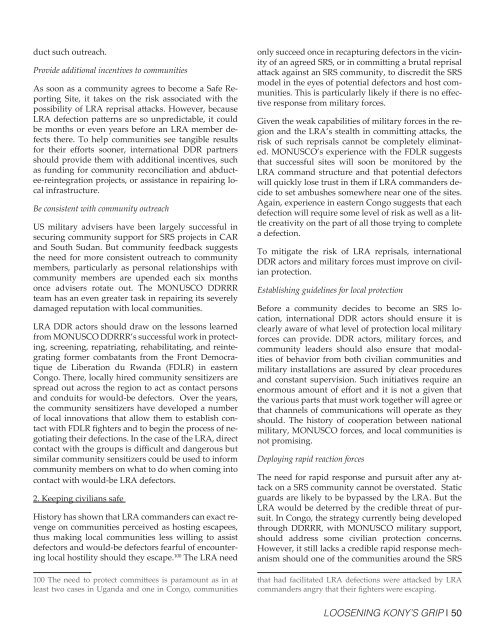Loosening-Konys-Grip-July-2013-FINAL
Loosening-Konys-Grip-July-2013-FINAL
Loosening-Konys-Grip-July-2013-FINAL
Create successful ePaper yourself
Turn your PDF publications into a flip-book with our unique Google optimized e-Paper software.
duct such outreach.Provide additional incentives to communitiesAs soon as a community agrees to become a Safe ReportingSite, it takes on the risk associated with thepossibility of LRA reprisal attacks. However, becauseLRA defection patterns are so unpredictable, it couldbe months or even years before an LRA member defectsthere. To help communities see tangible resultsfor their efforts sooner, international DDR partnersshould provide them with additional incentives, suchas funding for community reconciliation and abductee-reintegrationprojects, or assistance in repairing localinfrastructure.Be consistent with community outreachUS military advisers have been largely successful insecuring community support for SRS projects in CARand South Sudan. But community feedback suggeststhe need for more consistent outreach to communitymembers, particularly as personal relationships withcommunity members are upended each six monthsonce advisers rotate out. The MONUSCO DDRRRteam has an even greater task in repairing its severelydamaged reputation with local communities.LRA DDR actors should draw on the lessons learnedfrom MONUSCO DDRRR’s successful work in protecting,screening, repatriating, rehabilitating, and reintegratingformer combatants from the Front Democratiquede Liberation du Rwanda (FDLR) in easternCongo. There, locally hired community sensitizers arespread out across the region to act as contact personsand conduits for would-be defectors. Over the years,the community sensitizers have developed a numberof local innovations that allow them to establish contactwith FDLR fighters and to begin the process of negotiatingtheir defections. In the case of the LRA, directcontact with the groups is difficult and dangerous butsimilar community sensitizers could be used to informcommunity members on what to do when coming intocontact with would-be LRA defectors.2. Keeping civilians safeHistory has shown that LRA commanders can exact revengeon communities perceived as hosting escapees,thus making local communities less willing to assistdefectors and would-be defectors fearful of encounteringlocal hostility should they escape. 100 The LRA need100 The need to protect committees is paramount as in atleast two cases in Uganda and one in Congo, communitiesonly succeed once in recapturing defectors in the vicinityof an agreed SRS, or in committing a brutal reprisalattack against an SRS community, to discredit the SRSmodel in the eyes of potential defectors and host communities.This is particularly likely if there is no effectiveresponse from military forces.Given the weak capabilities of military forces in the regionand the LRA’s stealth in committing attacks, therisk of such reprisals cannot be completely eliminated.MONUSCO’s experience with the FDLR suggeststhat successful sites will soon be monitored by theLRA command structure and that potential defectorswill quickly lose trust in them if LRA commanders decideto set ambushes somewhere near one of the sites.Again, experience in eastern Congo suggests that eachdefection will require some level of risk as well as a littlecreativity on the part of all those trying to completea defection.To mitigate the risk of LRA reprisals, internationalDDR actors and military forces must improve on civilianprotection.Establishing guidelines for local protectionBefore a community decides to become an SRS location,international DDR actors should ensure it isclearly aware of what level of protection local militaryforces can provide. DDR actors, military forces, andcommunity leaders should also ensure that modalitiesof behavior from both civilian communities andmilitary installations are assured by clear proceduresand constant supervision. Such initiatives require anenormous amount of effort and it is not a given thatthe various parts that must work together will agree orthat channels of communications will operate as theyshould. The history of cooperation between nationalmilitary, MONUSCO forces, and local communities isnot promising.Deploying rapid reaction forcesThe need for rapid response and pursuit after any attackon a SRS community cannot be overstated. Staticguards are likely to be bypassed by the LRA. But theLRA would be deterred by the credible threat of pursuit.In Congo, the strategy currently being developedthrough DDRRR, with MONUSCO military support,should address some civilian protection concerns.However, it still lacks a credible rapid response mechanismshould one of the communities around the SRSthat had facilitated LRA defections were attacked by LRAcommanders angry that their fighters were escaping.LOOSENING KONY’S GRIP | 50


